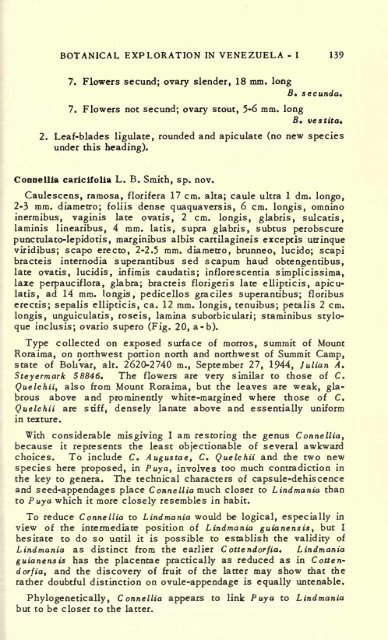PDF - University Library
PDF - University Library
PDF - University Library
You also want an ePaper? Increase the reach of your titles
YUMPU automatically turns print PDFs into web optimized ePapers that Google loves.
BOTANICAL EXPLORATION IN VENEZUELA - I 139<br />
7. Flowers secund; ovary slender, 18 mm. long<br />
B, secunda.<br />
7. Flowers not secund; ovary stout, 5-6 ram. long<br />
fl.<br />
vestita.<br />
2. Leaf-blades ligulate, rounded and apiculate (no new species<br />
under this heading).<br />
Connellia caricifolia L. B. Smith, sp. nov.<br />
Caulescens, ramosa, florifera 17 cm. alta; caule ultra 1 dm. longo,<br />
2-3 mm. diametro; foliis dense quaquaversis, 6 cm. longis, omnino<br />
inermibus, vaginis late ovatis, 2 cm. longis, glabris, sulcatis,<br />
laminis linearibus, 4 mm. latis, supra glabris, subtus perobscure<br />
punctulato-lepidotis, marginibus albis cartilagineis except is utrinque<br />
viridibus; scapo erecto, 2-2.5 mm. diametro, brunneo, lucido; scapi<br />
bracteis internodia superantibus sed scapum baud obtengentibus,<br />
late ovatis, lucidis, infimis caudatis; inflorescentia simplicissima,<br />
laxe perpauciflora, glabra; bracteis florigeris late ellipticis, apiculatis,<br />
ad 14 mm. longis, pedicellos graciles superantibus; floribus<br />
erectis; sepalis ellipticis, ca. 12 mm. longis, tenuibus; petalis 2 cm.<br />
longis, unguiculatis , roseis, lamina suborbiculari; staminibus styloque<br />
inclusis; ovario supero (Fig. 20, a-b).<br />
Type collected on exposed surface of morros, summit of Mount<br />
Roraima, on northwest portion north and northwest of Summit Camp,<br />
state of Boh'var, alt. 2620-2740 m., September 27, 1944, Julian A.<br />
Steyermark 58846. The flowers are very similar to those of C f<br />
Quelchii, also from Mount Roraima, but the leaves are weak, glabrous<br />
above and prominently white -margined where those of C.<br />
Quelchii are stiff, densely lanate above and essentially uniform<br />
in texture.<br />
With considerable misgiving<br />
I am restoring the genus Connellia,<br />
because it<br />
represents the least objectionable of several awkward<br />
choices. To include C. Augustae, C Quelchii and the two new<br />
species here proposed, in Puya, involves too much contradiction in<br />
the key to genera. The technical characters of capsule-dehiscence<br />
and seed-appendages place Connellia much closer to Lindmania than<br />
to P uya which it more closely resembles in habit.<br />
To reduce Connellia to Lindmania would be logical, especially in<br />
view of the intermediate position of Lindmania guianensis, but I<br />
hesitate to do so until it is possible to establish the validity of<br />
Lindmania as distinct from the earlier Cottendorfia. Lindmania<br />
guianensis has the placentae practically as reduced as in Cottendorfia,<br />
and the discovery of fruit of the latter may show that the<br />
rather doubtful distinction on ovule-appendage is equally untenable.<br />
Phylogenetically, Connellia appears to link Puya to Lindmania<br />
but to be closer to the latter.










![Novellen [microform] - University Library](https://img.yumpu.com/21939450/1/171x260/novellen-microform-university-library.jpg?quality=85)
![Anecdota Chisiana de re metrica [microform]](https://img.yumpu.com/21939448/1/190x239/anecdota-chisiana-de-re-metrica-microform.jpg?quality=85)



![Schollenbruch [microform] : Gedichte - University Library](https://img.yumpu.com/21939437/1/174x260/schollenbruch-microform-gedichte-university-library.jpg?quality=85)
